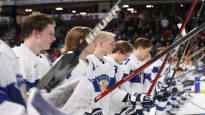According to Lämsä, the level of requirements for players should be significantly tightened in Finland, because the youth competitions are of an even tougher standard.
SpongeBob Forsberg,
Jussi Saarinen
For the first time in five years, Finland missed the quarter-finals of the under-20 world ice hockey championships played in Canada. The head coach of the team Tomi Lämsa says that the team’s access to the medal games depended on the small.
– The sled turned against Sweden in the last three minutes. If we had won that game, things would have been very different, especially in the eyes of the media. Analysis is done all the time with the coaching team and it is chewed over well.
According to Lämsä, who watched the previous World Cup in August from the stands, the level of the games in his twenties has taken a huge leap forward.
– It felt like the level of requirements rose a notch or two from those games, says Lämsä, who took over coaching responsibility after the games in August.
– The work needs to be sharpened. Not only the tactical and artistic side, but also the mental toughness and fortitude required to win. They are at an extremely tough level in the world. You have to somehow be able to jump on that train.
Young people need playing time
Canada celebrated the tournament win with their super promise by Connor Bedard under. In the future, Finland will also need well-skated, skilled and physical players.
According to Lämsä, young players should be given more responsibility and playing time in the SM league, so that their skills and fitness would be sufficient for international competitions for young people.
– The tournament showed it. The requirement of the game is so hard. If you come in as a six-minute player and suddenly jump to an 18-minute player, it’s hard to adjust to that in two weeks. The players from the top countries of the tournament are competing in the North American junior leagues and their own national leagues in top roles. That’s a really important consideration.
Of the field players of the Young Lions, only the defenders Topias Vilen, Aleksi Heimosalmi, Otto Salin and attackers Oliver Kapanen, Ville Koivunen and Lenny Hämeenaho have played more than 15 minutes per match in the SM league.
The attackers have received the least amount of playing time Sami Päivärinta, Alexander Kaskimäki and Konsta Kapanenwho have played less than nine minutes per game.
Defenders:
Vilén Topias, Pelicans 19.28
Heimosalmi Aleksi, Aces 16.06
Salin Otto, HIFK 15.59
Kiviharju Aron, TPS 11.55
Malinen Aleksi, JYP 11.08
Finland Jimi, TPS 11.01
Swedish Ville, KalPa 10.58
Ervasti Kalle, Lock 10.21
Attackers:
Kapanen Oliver, KalPa 16.41
Koivunen Ville, Kärpät 16.19
Hämeenaho Lenni, Aces 15.57
Huuhtanen Niko, Jukurit 14.31
Kemell Joakim, JYP 14.02
Väisänen Kalle, TPS 13.32
Jani Nyman, Ilves 12.33
Rönni Topi, Tappara 11.23
Lassila Jere, JYP 10.12
Päivärinta Sami, Lock 8.58
Kaskimäki Aleksanteri, HIFK 8.37
Kapanen Konsta, KalPa 7.43
Source: SM league player statistics.
According to Lämsä, there is a lot of work ahead if they want to succeed in the next junior tournaments. Defenders born in 2004 and 2005 are not seen worse in the ranks of SM league teams.
– There are 11 months until the next time the puck hits the ice. In the Ice Hockey Federation, we need to approach the clubs, bring a message about the World Cup and carefully analyze with them whether some things can be done better. Players are made to develop and through that the teams also succeed.
Success is built early
by Anton Lundell, Sebastian Ahon or Mikko Rantanen such clear first-round bookings are currently on the cards. Lämsä, who coached in the KHL for five years, thinks that Finland can afford to significantly tighten the level of requirements.
– I hope the future talents are training somewhere. It’s not enough to start thinking about what everyday life is like at the age of 15-16. It leaves much earlier. This is a big deal when it comes to children’s movement. We should be able to keep the masses involved and make everyday life high enough and the level of requirements high enough, Lämsä insists.
